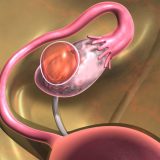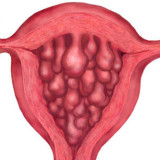Having diagnosed a cyst, a doctor always faces the question – to wait or to operate. There are cysts that disappear themselves. But there are also cases when cyst removal is the only option to cure the disease. What more, surgery delay is crucial and might be the reason there is no chance left to save the patient.
As a rule, waiting and monitoring, as a way of cyst treatment, is only used with functional ovarian cysts (corpus luteum). In case of the abnormalities cyst removal is necessary. But your doctor may have another opinion, which is of course prioritized. At first glance, everything is simple. But the complexity is that it can be very difficult to know functional cyst from the first medical observation, even using ultrasound.
The thing is that the functional cyst may look exactly the same on ultrasound as endometrioid or dermoid cyst. A follicular cyst can also be mistaken with cystadenomas.
Types of ovarian cysts – functional and neoplastic
When is it reasonable to wait
But there is one functional cysts feature which helps to diagnose the particular type of cyst using understand. Functional cyst changes over time. The cyst may disappear entirely within 1-3 months, decrease, or change their internal contents. There is no necessity for cyst removal with the corpus luteum disorder, and ultrasound monitoring can spare the patient from extra medical manipulations which are fairly invasive.
Observation in the short period of time helps to understand whether cyst is functional and will disappear after a while, or the patient needs a cyst removal. The most important is the surveillance should not exceed several months! Monitoring the cyst over a year in hope it will dissolve is dangerous wasting of time.
Functional cyst is quickly changing. When they arise they can disappear soon without a trace, or at least reduce in size. They can also change their structure (typical for a corpus luteum cyst). It is enough to do an ultrasound after the next menstrual period and then another in a month in order to notice these changes. If there are improvements, the size of the cyst decreased significantly, then the monitoring period may be prolonged. If there are no changes in several months then further monitoring is absolutely useless, and a cyst removal is required.
Ultrasound must be done not less than 1 time in 3 months. The total observation time should not exceed 1 year.
Things to consider deciding on the operation
Cyst removal should not be done immediately after diagnosis
Some doctors, having found an ovarian cyst during ultrasound examination (certain about its benign nature) immediately send the patient for ovarian cyst removal. This is right for endometrioid or dermoid cysts. But not for a corpus luteum. That is why it’s important to be sure about the type. It happens doctors find only a cyst of corpus luteum after the operation has started. Or the cyst has disappeared itself by the time.
Even the most experienced professionals are not always able to distinguish one type of cyst from the other. Doctors are often concerned of a cyst size, especially when they see the one of more than 5 cm. It certainly causes some risks and discomfort. That is why ovarian cyst removal is prescribed. But the size is not always crucial. Ultrasound monitoring for a period is still necessary first for a corpus luteum cyst.
A period of several months is not a big deal for a functional ovarian cyst. And it gives you a chance to avoid surgery. Though it is not acceptable when we exclude functional cyst. In this case waiting is a risk, and ovarian cyst removal ought to be done as soon as possible.
Complications are not always reasons to perform cyst removal
Functional cysts is a capsule. Some patients fear to madness of the cyst rupture or torsion. Even better, some doctors do. After all, these complications are emergencies. That’s why some medical specialists prefer elective surgery to avoid emergency surgery later. Even if the cyst is functional.
But in fact, it’s not that bad. A lot depends on the size of the cyst. The burst is not quite common. Besides, burst of a small functional cyst (up to 5 cm) usually causes very little pain in the abdomen and is not dangerous at all. Some don’t even notice the moment in the rush of modern life. Of course, large cysts may cause more serious symptoms and even require emergency surgery.
Therefore, whatever is the size it is very important to avoid excessive exercise, sudden movements, fitness activities and dances. With the cyst of big sizes it is better to postpone flights and long trips.
These simple recommendations help to wait for the next ultrasound without problems.
Too long observation
There is another external – when a doctor continue the observation for too long. Considering the cyst is functional they refuse to remove cyst. In a year or two a falsely diagnosed tumor does a great harm to the patient. Dermoid cyst enlarges, and sometimes bursts. Not mentioning the constant discomfort through all this time.
Ovarian cyst treatment is not that easy. A lot depends on your age, medical history, fertility, etc. Each case is dealing individually with specific recommendations. Only a doctor can decide whether cyst removal is necessary, and when it is better to be performed.















